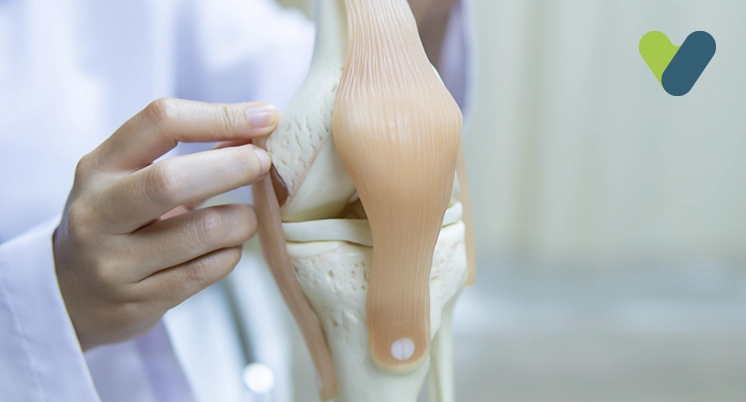A meniscus tear is one of the most common injuries for athletes, but other people also get it sometimes. Whether it is caused by an injury or due to other factors, such as old age, arthroscopic meniscus surgery is the best treatment method available today.
To reduce the pain and increase the mobility of the knee, your doctor will recommend that you undergo meniscus tear surgery. Upon probing the joint during the operation, the surgeon will decide whether to perform a meniscectomy or to repair the meniscus.
What is a meniscus? What are the type of injuries treated by arthroscopic meniscectomy?
The meniscus is a C-shaped piece of rubbery cartilage located between the thigh and shin bones. Each knee has two menisci, one on the inner side and the other on the outer side of the joint. The main function of the meniscus is to act as a shock absorber for the knee and stabilise the joint. When the meniscus is torn due to an injury, it can cause pain, discomfort, and even lock the knee, all of which greatly impact the injured person’s mobility.
Since the meniscus has blood flow on the edges where it is attached to ligaments, people may not know they have a meniscal tear until their knees start to pop or lock. For this same reason, the body cannot heal a meniscal tear, and an arthroscopic meniscectomy (or surgical removal of the meniscus) is recommended by the doctor in most cases. There are different types of meniscal tears; some of the common types are listed below:
- Bucket-handle tear This type of meniscal tear causes the meniscus to break in the middle and looks like a bucket handle or a "D." The torn part (still attached from the edges) may roll and slide in the middle of the joint, causing the knee to lock.
- Flap tear This type of meniscal tear is caused by a tear in the middle section on the inner side of the meniscus and forms a flap that may cause problems with mobility.
- Radial tear This type of meniscal tear is like a small cut in the middle of the C-shaped meniscus that reaches the vascular region (with nerves and blood flow).
- Degenerative tear In this type of meniscal tear, the inner section of the meniscus is chipped away, likely due to wear and tear.
Preparing for the meniscus surgery
Once the decision is made, your doctor will finalise a suitable date and ask you to take some tests to check your readiness for the surgery. These tests may include a complete blood count, urine sample, X-ray, and electrocardiogram (ECG or EKG). If any of these tests are abnormal, or if your surgeon suspects an underlying health condition is interfering, they will refer you to your primary care physician. The doctor will recommend that you lose weight if you are obese in order to expedite your recovery post-surgery. People are also required to fast for about 8 to12 hours before the surgery.
Meniscus surgery procedure
After admitting you to the hospital, you will likely change into a dressing, and the nurses will prep the knee area for surgery. They will shave your knee and put an IV line in your arm.
You will then be taken to the operating room and given anaesthesia to either numb your lower body or put you to sleep. After cleaning the skin around your knee, the surgeon will mark it for making incisions. Since arthroscopic meniscus surgery is a minimally invasive procedure, you will have small scars.
The surgeon will then make small cuts in your knee to create portals for the arthroscope and other devices to operate on the joint. Using the real-time images on the screen projected by the arthroscope, the surgeon will assess the type of tear and decide whether to repair the meniscus (rare) or alter it.
If the meniscal tear is closer to the capsular region, the tear can be repaired. This type of surgery is recommended only for select patients who fit the criteria. In arthroscopic meniscal repair, most of the procedure remains the same, but the surgeon uses anchors and sutures to secure the meniscus in place and promote speedy recovery instead of removing the torn part.
If the meniscus cannot be repaired, the surgeon will then perform a partial or total meniscectomy (removal of the meniscus) with the help of arthroscopic scissors; the torn meniscus is removed with the help of a grabber.
Next, the surgeon will inspect the remaining meniscus and smooth out the edges using a shaver tool. After ensuring everything looks fine, the surgeon will close the portals and stitch the cuts. Then your knee will be covered in bandages, and you will be kept under observation for a day or two.
After surgery care and rehabilitation
After getting discharged from the hospital, you will head home, where you will be given medications intravenously and walk only when necessary using a cane or walker. The stitches are usually removed in a week or two.
You will likely be recommended to wear a knee brace to add stability to the joint. Additionally, physical therapy will be recommended to help you get back on your feet as soon as possible.
Generally, the recovery from arthroscopic meniscus surgery takes about 6 to 12 weeks. During this time, you must be extremely cautious to avoid any injuries to your leg.
Risks associated with the meniscus tear surgery
Here are some of the risks associated with arthroscopic meniscal repair:- Arthritis later in life due to the increased friction in the knee joint
- Blood clots or infections
- Damage to nerves and blood vessels near the knee
- Allergic reaction to the anaesthesia
* The sutures in the meniscus, increase the chances of the patient tearing their meniscus again during high-impact activities or injuries. This may require another surgery. Although arthroscopic meniscus surgery is a relatively safe procedure, some people may experience these risks. If you notice any of the following, you should consult your doctor to avoid any complications:
- Fever higher than 101° F
- Difficulty in breathing
- Chest pain
- Foul-smelling liquid for the scars
- Unexplained pain or swelling in the leg
How much does arthroscopic meniscus surgery cost?
Usually, arthroscopic meniscus surgery costs around INR 60,000 to INR 80,000. The figure varies depending upon various factors, including other facilities provided by the hospital and the location.
Arthroscopic meniscus repair costs in India may be a little higher than the cost of arthroscopic meniscectomy because the former requires additional sutures and anchors in the knee joint.
Outlook for patients
People who have had meniscus surgery may not be able to enjoy high-impact sports or dance, as these activities can cause abrasions in the knee joint. This increases the patient’s chances of getting arthritis. Additionally, the doctor recommends that people who have undergone meniscectomy or meniscal repair surgery maintain a healthy weight, as excess weight gain puts unnecessary stress on the knee joint.
Although meniscus surgery limits the patient’s activity to a certain level, it helps avoid pain and improves a person’s mobility significantly. Meniscus surgery completely relieves knee pain in most patients and greatly reduces it in others.


